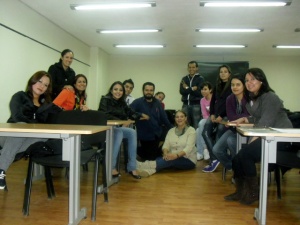I am sitting here on a summer raining day with a cup of coffee at the side and I cannot think but “what a perfect moment to write about Endings and Beginnings”. I consider myself a very passionate person, a hopeless romantic but… that is another story (laughing at myself). Well, passion about languages and passion about English was what leaded me to this new challenge in my life.
If I could rewind the time I would have chosen a completely different path from Accounting (which I do for a living) I would choose to become an interpreter/translator, a teacher or pedagogy. How right my mother was when she tried me to convince me to study Education but hey, here are some good news , it is never too late to do what you want to do!
So here I was, eight years later after I finished nine semesters of English at Language Department of the UMSNH doing some research so I could get certified with the teaching tools and techniques to step in front of a class and teach English. I found some interesting programs, but most of them were abroad or at least I had to leave the state to do it so. I tried the CAE training but it didn’t work out well, since I was the only one attending, I guess only me and two other people were interested. I got frustrated, how come I couldn’t be able to find what I was looking for here in my own city?…
Suddenly, out of nowhere and without been such as stubborn person as I usually am the chance of taking the tkt course was in front of me, a great opportunity , why not to grab it?
How I have grown since that? Wow! My expectations were big but the results are twice better! This course made me feel alive again in some way, I was hungry of knowledge and I am and more now. Knowing that you are persuading your goals gives you a special daily strength.
The main reason I wanted to become a teacher was first off to be able to share knowledge for people who are anxious to learn as I am, being able to manage my time and hopefully teach abroad.
Although I don’t discard none of my just mentionated desires, there’s is something that has growing on my soul and it is to make the change in México. I am so grateful that with the effort of some people, an EFL teacher support community has started here and I want to be part of it.
I don’t want to let pass the chance to express the admiration that I have for my teacher who is an important piece on this movement for educational change and who since the very first day of class said I am not a superpower person but for me she is.
I can’t wait to start teaching! I have this heart feeling that through the process I will ended up loving it!
Thanks to this course I am a better person, not only have grown academically but personally as well. I have always wailed because I am such a sensitive person and knowing that as a teacher you must have that sensitive touch makes me realized and encourage all my potentials
Blogging? Gloogster? Voicethreat?… Yeap, I was scared to death to deal with technology which is not my main skill, well guess what? I knew from the first moment is scary but challenging, I am sure that makes this course more interesting to me. The key is to really confront our fears, because when we do, and when we look at them, we really begin to realize that we are capable of handling them.
My main goal was, is and will be ¡ I can do this! 😉









